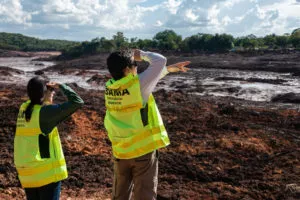In late January 2019, the collapse of two tailings dams at Vale’s Brumadinho iron ore mine in Brazil killed hundreds of workers and local residents in the state of Minas Gerais. Even more horrifying, the Brumadinho catastrophe was a tragedy foretold, with unheeded prior warnings from mine inspectors and Vale’s own workers. This disaster came on the heels of other tailings disasters, notably at the Mount Polley gold and copper mine in Canada and the BHP-Vale owned Samarco iron ore mine in Mariana, Brazil.
How did one of the world’s largest mining companies, Vale, ignore the risks identified by workers and mine inspectors, and fail to learn from its previous tailings disaster? How many more ticking time bombs around the world are endangering communities, workers, and ecosystems at this very moment?
Independent research that analyzes decades of data on mine waste dam failures has shown that these catastrophic tailings dam failures are occurring more frequently and are predicted to continue to increase in frequency. This is attributed to multiple factors, including inadequate tailings facilities design, age of facilities, unanticipated weather conditions due to climate change, and mining companies tapping lower grade ores, resulting in larger volumes of mine waste.
And yet, very little is known about these tailings storage facilities (TSFs) – their location, size, scale, ownership, even how many exist around the world.
This is about to change.
In April 2019, the Church of England pension funds and the Swedish Council of Ethics, representing a group of 96 investors with over $10 trillion in assets, launched the Investor Mining & Tailings Safety Initiative. They sent letters to 683 mining companies, asking detailed questions about ownership, operating status, physical size, construction and independent risk assessment at their TSFs. These companies were given 45 days to respond, and were required to post this information publicly on their websites.
This is the first time that investors have demanded transparency and disclosure of mining companies on this scale – and this may well be the game-changing move that’s needed to understand and mitigate risks at TSFs.
The investor action has lit a fire under some of the world’s largest mining companies, many of whom have swiftly responded, publishing their disclosures to meet the June 7 deadline. The Swiss mining company Glencore’s disclosure indicated that 14 of its facilities carry “extreme risk” in the event of failure – many in Peru – and another 100 are considered high-risk. Australian miner BHP, the world’s largest mining company, disclosed that five of its tailings dams were at “extreme consequence of failure,” and has set up a tailings task force to improve safety.
In May, the investor group, Principles for Responsible Investment (PRI), took another important action. PRI, along with the United Nations Environment Programme (UNEP), which published a rapid response assessment on tailings dam safety in 2017, and the International Council on Mining and Metals, an association of 26 of the world’s largest mining companies, launched a Global Tailings Review process. At UNEP’s invitation, Earthworks agreed to serve on the multi-stakeholder advisory panel to the Global Tailings Review, which is chaired by Professor Bruno Oberle, former Swiss Secretary of State for the Environment. Other advisory panel members include IndustriALL Global Union, Munich Re, the International Finance Corporation, and the Columbia University Water Center.
Earthworks believes that the strongest outcomes will result from a process co-governed by civil society members, particularly mining-affected communities and workers representatives. We support processes that embody this commitment to co-equal governance, such as the Initiative for Responsible Mining Assurance (IRMA). But this is an all hands-on-deck moment – and we will willingly pitch in to advance efforts that will shore up tailings dam safety, increase transparency, and protect people and the environment.
The world can no longer bear the costs of dragging feet, making excuses, or putting shareholder returns before people’s lives. Without exception, safety must be the leading priority at tailings dams and storage facilities around the world. Mining companies must act on the findings of their TSF reviews and ensure that risks to communities, workers and ecosystems are mitigated and managed as soon as possible.

